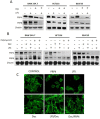Decursin negatively regulates LPS-induced upregulation of the TLR4 and JNK signaling stimulated by the expression of PRP4 in vitro
- PMID: 32158615
- PMCID: PMC7048231
- DOI: 10.1080/19768354.2020.1726811
Decursin negatively regulates LPS-induced upregulation of the TLR4 and JNK signaling stimulated by the expression of PRP4 in vitro
Abstract
The current investigation was carried out to analyze the correlation of bacterial lipopolysaccharide (LPS) and pre-mRNA processing factor 4B (PRP4) in inducing inflammatory response and cell actin cytoskeleton rearrangement in macrophages (Raw 264.7) and colorectal (HCT116) as well as skin cancer (B16-F10) cells. Cell lines were stimulated with LPS, and the expression of PRP4 as well as pro-inflammatory cytokines and proteins like IL-6, IL-1β, TLR4, and NF-κB were assayed. The results demonstrated that LPS markedly increased the expression of PRP4, IL-6, IL-1β, TLR4, and NF-κB in the cells. LPS and PRP4 concomitantly altered the morphology of cells from an aggregated, flattened shape to a round shape. Decursin, a pyranocoumarin from Angelica gigas, inhibited the LPS and PRP4-induced inflammatory response, and reversed the induction of morphological changes. Finally, we established a possible link of LPS with TLR4 and JNK signaling, through which it activated PRP4. Our study provides molecular insights for LPS and PRP4-related pathogenesis and a basis for developing new strategies against metastasis in colorectal cancer and skin melanoma. Our study emphasizes that decursin may be an effective treatment strategy for various cancers in which LPS and PRP4 perform a critical role in inducing inflammatory response and morphological changes leading to cell survival and protection against anti-cancer drugs.
Keywords: JNK; LPS; PRP4; TLR4; decursin; inflammation.
© 2020 The Author(s). Published by Informa UK Limited, trading as Taylor & Francis Group.
Figures




References
-
- Chi H-J, Kim H-S.. 1988. Studies on essential oils of plants of angelica genus in Korea (I).-essential oils of angelicae gigantis radix. Korean J Pharma. 19:239–247.
LinkOut - more resources
Full Text Sources
Research Materials
Miscellaneous
